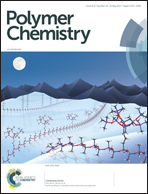Highly thermal conductive resins formed from wide-temperature-range eutectic mixtures of liquid crystalline epoxies bearing diglycidyl moieties at the side positions†
Abstract
To develop advanced thermally conductive epoxy resins with liquid crystallinity, three novel liquid crystalline epoxies (LCEs) were synthesized via the substitution of phenylcyclohexyl (PCH) mesogenic moieties into the 2,5 positions of diglycidyl terephthalate. Mesomorphic properties of LCEs were evaluated by differential scanning calorimetry (DSC), polarized optical microscopy (POM), and X-ray diffraction (XRD). All LCEs exhibited an enantiotropic smectic phase on heating and cooling. Remarkably, the smectic phase with a wide temperature range of 98–145 °C was observed for the eutectic mixtures of a family of stable smectic LCEs. The selection of optimum curing agents, compositions of LCEs and curing agents, and curing conditions were determined based on physical, chemical, and thermal properties of LCEs and curing agents. The thermally cured LCEs at the LC phase exhibited a high thermal conductivity of 0.4 W m−1 K−1.



 Please wait while we load your content...
Please wait while we load your content...